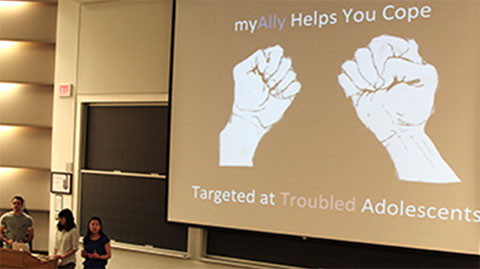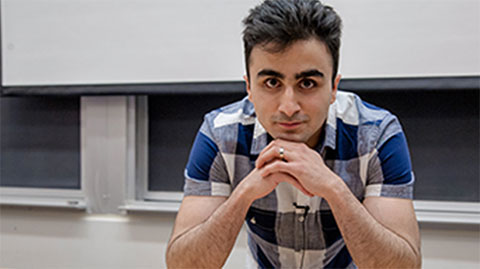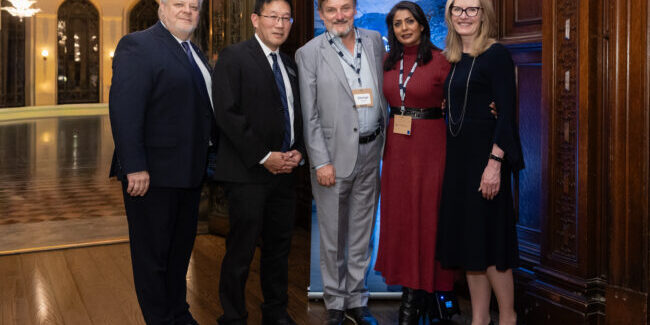
Today it’s mostly our smartphones and tablets that are touch sensitive, but soon it could be our desks, car dashes or even our kitchen counters. That’s the technology behind XTouch, a new app from U of T Engineering students.
“XTouch extends the tactile environment beyond the surface of that mobile device,” said app developer Amin Heidari (ECE MASc 1T1). “Two taps in different spots act as two different buttons on the table.” The technology is already in use in two games available on the App Store, with more coming soon.
XTouch was crowned ‘Top App’ in a recent U of T Engineering app competition. It was one of 10 apps selected from more than 100 developed over the past year under the supervision of Professors Parham Aarabi and Jonathan Rose, both of The Edward S. Rogers Sr. Department of Electrical & Computer Engineering. The top 10 most innovative and exciting apps went head-to-head for a $1,000 grand prize, furnished by the Mobile App Lab.
The 10 groups demonstrated their apps Thursday night to a crowd of industry representatives, professors and students, including three judges: Darrell Etherington from TechCrunch, Lenny Freilich from Ontario Centres of Excellence and Arshia Tabrizi (CompE 9T5), technology lawyer and founder of the social video platform Vidoyen.
“The quality of presentations tonight was extremely high,” said Tabrizi. “It’s amazing what these students achieved in a relatively short period of time.” Added Freilich: “I like the interdisciplinary aspect of it—they’re working on, and solving, real problems.”
One contender was Baton, an app that enables teachers to harness the power of the ubiquitous smartphones for good. It invites students to participate in more productive classroom discussion. High-school teacher and M.Ed candidate Zack Teitel, in collaboration Victor Chen, a master’s of information student, and Fiona Zhao, a master’s student studying applied computing, developed the app.
“I’ve worked in inner-city environments and very affluent schools, and in every classroom I’m in—I can’t stress this enough—every single student has a smartphone,” said Teitel. “We need to start presenting opportunities to use the technology in a positive way, rather than a distracting way.” [Listen to an interview with Zack Teitel on CBC’s Metro Morning]

Apps such as Face2Name help doctors and nurses, working in enormous hospitals with rotating staff, find their patient’s caregiver in a hurry. Critter is a virtual pet that stops us from staring at our phones like zombies, sending out barks and purrs whenever we pass another person running the app. SkinLens uses photo-filter technology to keep tabs on that scary-looking mole, checking for symmetry and colour changes.

The runner-up app, called Surgical Trainer and Navigator, or STAN, helps surgeons in training get empirical feedback about their proficiency in the operating room by tracking hand motions during surgery. Competition was fierce—at the end of the night, only a single point separated each of the top six apps.
“It’s thrilling to see this focus on interdisciplinary development really coming to fruition,” said Professor Rose, founder of The Centre for Inter-Disciplinary Mobile Software and Hardware. Professor Rose created a graduate course, ECE1778, to unite non-programmers, or “appers,” and students with programming skills to build mobile apps that solve a real-world problem in the apper’s field. It’s a new research area, built entirely on harnessing the power of the tiny computers we all carry around in our pockets and the sensors that come with them.
“To me, I think we’ve seen perhaps one of the greatest surges of creativity in human history in the last six years,” said Professor Rose, “It spans all different areas of endeavour. One of the beliefs that I think Parham and I share is the insight that there are lots of great ideas to come.”
More information:
Marit Mitchell
Senior Communications Officer
The Edward S. Rogers Sr. Department of Electrical & Computer Engineering
416-978-7997 | marit.mitchell@utoronto.ca




